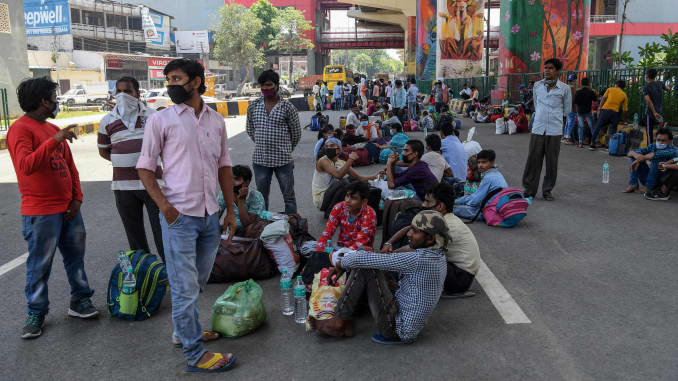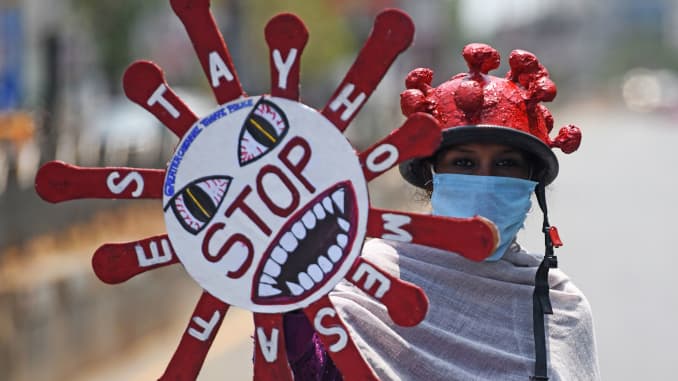Key Points
- India is set to report growth numbers for the first three months of this year, and analysts expect Asia’s third largest economy to have expanded at a slower pace.
- According to economists polled by Reuters, gross domestic product for the January to March quarter is expected to have grown at 2.1% from a year ago, marking the weakest growth since comparable records began in early 2012.

India is set to report growth numbers for the first three months of this year, and analysts expect Asia’s third largest economy to have expanded at a slower pace.
On Friday, India will release data on its gross domestic product for the January to March period.The economy is expected to have expanded by 2.1% compared to a year ago, according to 52 economists polled by Reuters. If so, it would be India’s weakest growth since comparable records began in early 2012, the news wire reported.
Growth momentum in South Asia’s largest economy was already decelerating in previous quarters, before the coronavirus pandemic forced the country into a nation-wide lockdown that was extended multiple times, and grounded most economic activities in the ensuing weeks.
GDP is expected to worsen in the current April to June quarter, according to investment bank Goldman Sachs which recently predicted a massive 45% decline during that period, compared to the previous three months.
Some countries have already registered a “notable deceleration” in growth in the first three months of the year, due to the fallout of volatile financial markets, a marked slowdown in China, and weakening flows in tourism and trade sectors, Radhika Rao, an economist at Singapore’s DBS Group, said in a note.
“Households and businesses also likely grew cautious on their spending as it (was) a matter of not ‘if’ but ‘when’ the pandemic would quicken on their shores,” she wrote. “India is likely to witness something similar, not helped by the decelerating momentum in growth even prior to the infection spread.”
Performance indicators
Several high-frequency data pointed to a significant impact in the January-March period, which is also the fourth quarter of India’s fiscal year 2020.
The Index of Industrial Production, a composite indicator used to measure the level of industrial activity in the Indian economy every month, was down 16.65% in March from a year ago — or lower by 10% from February.
Factory activities slipped, diesel consumption was down and passenger vehicle sales almost halved in March.
“High-frequency growth indicators are exhibiting broad-based declines across indicators on both the demand and the supply sides,” Sonal Varma, chief economist for India and Asia ex-Japan at Nomura, said in a note. She explained that data showed declines in the services sector and in the consumption of non-essential goods exceeded the slump in investment and industrial activity.
Varma pointed out that while the April data captured the “most intense period” of the lockdown, March data already showed a slump in consumption.
Dismal outlook
The infection’s spread accelerated in India by March, and it forced the government to implement a national lockdown in the last week that month. As the number of officially reported cases climbed, the shutdown was extended multiple times.
In April, however, some of those restrictions were relaxed, and subsequently, districts were demarcated based on the risk of spreading the infection. Some restrictions are set to be eased first in lower risk zones.
More than 158,000 people are now confirmed to have been infected in India and more than 4,000 have died, according to Johns Hopkins University data.
Nomura’s Varma said that while in theory, the partial relaxation of lockdown measures and the division of regions into low-risk or high-risk zones should open up around 70% of the economy on a sector-by-sector basis, there are other practical challenges to consider.

“Restrictions on inter-state travel, labour shortages, new social distancing norms and the absence of a homogeneous market for both demand (for goods) and supply (of inputs) suggest that, even as capacity utilization is likely to rise from April lows, it will likely remain ‘sub-optimal’ for much longer,” she said in the note.
Even when businesses are able to open up, they will have to deal with severe cash flow shocks, as they struggle to remain solvent and search for fresh financing, Varma added.
DBS’ Rao said while the current April-June quarter will mark the trough in the current cycle, “consumer discretionary sectors, production and services, are likely to take longer to recover.”
A strong agricultural sector may help to offset some of that weakness, Rao said, adding that risks of a second wave of infection domestically also warrants attention. DBS predicted a 1.3% growth for the January-March period compared to a year ago.

